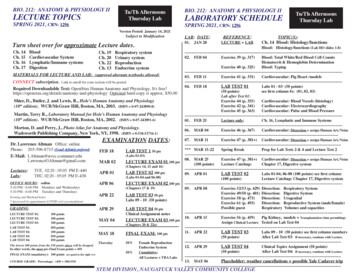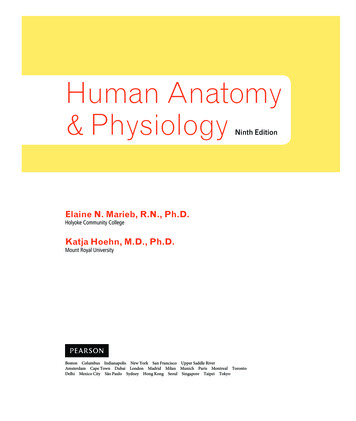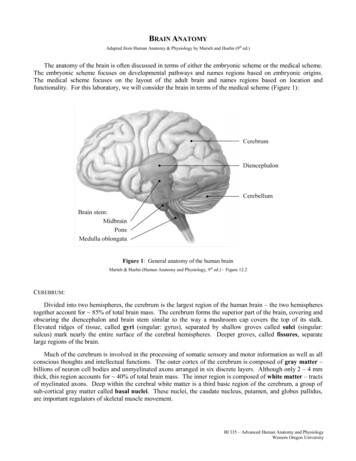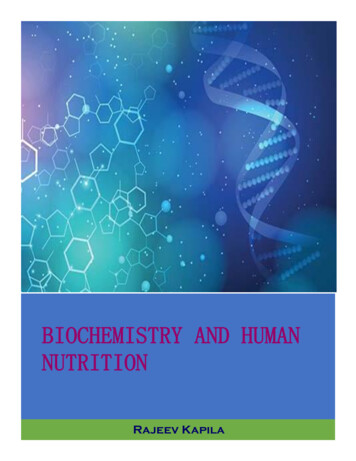
Transcription
Human Physiology/Nutrition1Human Physiology/Nutrition The gastrointestinal system — Human Physiology — The endocrine system Homeostasis — Cells — Integumentary — Nervous — Senses — Muscular — Blood — Cardiovascular — Immune — Urinary — Respiratory— Gastrointestinal — Nutrition — Endocrine — Reproduction (male) — Reproduction (female) — Pregnancy — Genetics — Development —AnswersThe Community and Nutrition ProgramsConnections between nutrition andhealth have probably been understood,at least to some degree, among allpeople of all places and times. Forexample, around 400 BC Hippocratessaid, "Let food be your medicine andmedicinebeyourfood."Understanding the physiological needsof our cells helps us understand whyfood has such an impact on overallhealth. In this chapter we introducenutrition by examining how cells usedifferent nutrients and then discussdisease conditions that are tied tonutritional problems.Nutrition and Health inthe CommunityThe nutritional status of people in ourcommunities is a concern not only forquality of life, but also for economics (treating illness costs far more than preventing it). Various public healthagencies are striving to prevent nutritional deficiencies and improve overall health. In the U.S., the governmentsupplies a variety of resources such as state assistance, WIC (Women Infant and Child), and so forth. In addition,there have been many government agencies and voluntary health and scientific associations, such as the AmericanHeart Association, that focus on life style and dietary factors that prevent chronic and life-threatening diseases. TheU.S. Department of Agriculture (USDA) and the U.S. Department of Health and Human Services (USDHHS)developed dietary guidelines in 1977 that were compiled and displayed as the food guide pyramid. The food guidepyramid was revised as "My Pyramid," but this new chart is confusing to most people. Harvard School of PublicHealth developed an alternative healthy eating pyramid (shown at left) based on long-term nutritional studies. Thispyramid differs from the old USDA pyramid in several key aspects: for example, exercise is at the bottom to remindus of its important role in our health. Also, not all carbohydrates are at the bottom (white bread, white rice, andpotatoes are now at the top with sugars), and not all oils are at the top (plant oils are at the bottom). Other resource,such as the Recommended Daily Allowance (RDA) have helped people become more aware of nutritional needs, yetobesity and chronic health problems continue to rise.Harvard's Food Pyramid
Human Physiology/NutritionNutritional RequirementsOur bodies have both caloric and nutritional needs. Living tissue is kept alive by the expenditure of energy in ATPmolecules, which energy came from the break down of food molecules. Caloric need refers to the energy neededeach day to carry out the varied chemical reactions in each cell. When looking at a nutritional label, we can easilysee how many Calories are in a serving. These Calories (big "C") are actually kilocalories (1000 calories).Technically, a calorie (little "c") is the amount of energy needed to raise the temperature of 1 mL of water by 1 C.How many Calories a person needs daily varies greatly by age, sex, height, and physical activity levels. If theamount of energy taken in exceeds the amount of energy used, then the excess energy is stored as adipose tissue(fat), regardless of the source of the energy.In addition to daily energy needs, there are nutritional needs to prevent the body from losing its own fats,carbohydrates, and proteins. Such molecules are continuously broken down, and must be replaced regularly.Essential amino acids and essential fatty acids are particularly important building blocks in replacing thesemolecules. Vitamins and minerals are not used as energy, but are essential in tissue and enzyme structure orreactions.CarbohydratesMacronutrientAn energy-yielding nutrient. Macronutrients are those nutrients that together provide the vast majority ofmetabolic energy to an organism. The three main macronutrients are carbohydrates, proteins, and fat.MicronutrientsMicrominerals or trace elements, are dietary minerals needed by the human body in very small quantities(generally less than 100mg/day) as opposed to macrominerals which are required in larger quantities.FunctionsGlucose it is the most easily used by the body. It is a simple carbohydrate that circulates in the blood and is themain source of energy for the muscles, central nervous system, and brain (the brain can also use ketonebodies).Carbohydrates are made of organic compounds carbon, hydrogen, and oxygen.There are three sizes of carbohydrate and they are distinguished by a classification of two that is, simplecarbohydrates (mono saccharides and disaccharides) and complex carbohydrates (polysaccharides). Polysaccharidesare the most abundant carbohydrate in the body along with glycogen.The break down of polysaccharides goes as follows: Polysaccharides are digested into monosaccchorides includingglucose which goes into the intestinal epithelium and into the bloodstream. The molecules of glucose are taken byglucose transporters and delivered into the cells of the body. While glucose is in the cells it can be oxidized forenergy or provide substrates to other metabolic reactions or of course into glycogen for storage.A. Monosaccharides Single carbohydrate unit such as, Glucose, Fructose, and Galactose.B. Disaccharides Two single carbohydrates bound together such as, Sucrose, Maltose, and Lactose.C. Polysaccharides Have many units of monosaccharides joined together such as, Starch and Fiber.FiberFiber is carbohydrates that cannot be digested. It is in all eatable plants such as fruits vegetables, grains andLegumes. There are many ways of categorizing fiber types. First, from the foods they come from such as grains,which is called cereal fiber. Second, if they are soluble fiber or insoluble fiber. Soluble fiber partially dissolves inwater and insoluble fiber does not.2
Human Physiology/NutritionAdults need about 21-38 grams of fiber a day. Children ages 1 and up need 19 grams a day. On average Americanseat only 15 grams a day.Fiber helps reduce the chances of having the following conditions: colon cancer, heart disease, type 2 diabetes,diverticular disease, and constipation.Glycemic IndexGlycemic Index is a new way of classifying carbohydrates. It measures how fast and how far blood sugar will riseafter consuming carbohydrates. Foods that are considered to have a high glycemic index are converted almostimmediately to blood sugar which causes it to rise rapidly. Foods that are considered to have a low glycemic indexare digested slower causing a slower rise in blood sugar. Examples of high glycemic index foods are potatoes, whiterice, white flour, anything refined, anything with a lot of sugar which includes high fructose corn syrup. Examples oflow glycemic index foods are whole grains (brown rice, 100% whole wheat bread, whole grain pasta, high fibercereals), high fiber fruits and vegetables, and many legumes. According to the Harvard School of Public Health,"The most comprehensive list of the glycemic index of foods was published in the July, 2002, issue of the AmericanJournal of Clinical Nutrition. A searchable database maintained by the University of Sydney is available online."ProteinsFunctionsProtein forms hormones, enzymes, and antibodies. It is part of fluid and electrolyte regulation, the bufferingeffect for pH, and transporter of nutrients. A good example of a protein is the oxygen carrying hemoglobinfound in red blood cells.Proteins are made of carbon, hydrogen, oxygen, and nitrogen, an inorganic molecule, the thing that clearlydistinguishes them from the other macronutrients.A. Amino acids are the building blocks of proteins.B. Polypeptide are a group of amino acids bonded together 10-100 or more.The body requires amino acids to produce new body protein (protein retention) and to replace damaged proteins(maintenance) that are lost in the urine.Proteins are relatively large molecules made of amino acids joined together in chains by peptide bonds. Amino acidsare the basic structural building units of proteins. They form short polymer chains called peptides or longerpoly-peptides which in turn form structures called proteins. The process of protein synthesis is controlled by anmRNA template. In this process tRNA transfers amino acids to the mRNA to form protein chains.There are twenty standard amino acids used by cells in making proteins. Vertebrates, including humans, are able tosynthesize 11 of these amino acids from other molecules. The remaining nine amino acids cannot be synthesized byour cells, and are termed "'essential amino acids'". These essential amino acids must be obtained from foods.The 9 Essential Amino Acids have the following names: Histidine, Isoleucine, Leucine, Lysine, Methionine,Phenylalanine, Threonine, Tryptophan, ValineYou can remember these with this saying “Hey It's Like Lovely Material; Please Touch The Velvet”.The 11 Non-essential Amino Acids are as follows:Alanine, Arginine, Aspartic acid, Cysteine, Cystine, Glutamic acid, Glutamine, Glycine, Proline, Serine, TyrosineHow about this memory device, "Almost Always Aunt Cindy Can Get Great Gum Popping Sounds Together" (Thissection needs to be corrected. Cystine is not one of the 20 common amino acids. It should be replaced by asparaginewhich is missing from the list. Also histidine is not essential for adults while cysteine, tyrosine, histidine, andarginine are required for infants and growing children. Some amino acids are also essential for specificsubpopulations, e.g., tyrosine for individuals with PKU.)3
Human Physiology/Nutrition4The 20 Amino Acids and What They Do!Amino AcidAbbrev.RemarksAlanineAAla Very abundant, very versatile. More stiff than glycine, but small enough to pose only small steric limits for the proteinconformation. It behaves fairly neutrally, can be located in both hydrophilic regions on the protein outside and thehydrophobic areas inside.CysteineCCys The sulfur atom binds readily to heavy metal ions. Under oxidizing conditions, two cysteines can join together in adisulfide bond to form the amino acid cystine. When cystines are part of a protein, insulin for example, this stabilizestertiary structure and makes the protein more resistant to denaturation; disulphide bridges are therefore common inproteins that have to function in harsh environments including digestive enzymes (e.g., pepsin and chymotrypsin) andstructural proteins (e.g., keratin). Disulphides are also found in peptides too small to hold a stable shape on their own(e.g., insulin).Aspartic acid DGlutamateAsp Behaves similarly to glutamic acid. Carries a hydrophilic acidic group with strong negative charge. Usually is locatedon the outer surface of the protein, making it water-soluble. Binds to positively-charged molecules and ions, often usedin enzymes to fix the metal ion. When located inside of the protein, aspartate and glutamate are usually paired witharginine and lysine.EGlu Behaves similar to aspartic acid. Has longer, slightly more flexible side chain.FPhe Essential for humans. Phenylalanine, tyrosine, and tryptophan contain large rigid aromatic group on the side chain.These are the biggest amino acids. Like isoleucine, leucine and valine, these are hydrophobic and tend to orient towardsthe interior of the folded protein molecule.GlycineGGly Because of the two hydrogen atoms at the α carbon, glycine is not optically active. It is the smallest amino acid, rotateseasily, adds flexibility to the protein chain. It is able to fit into the tightest spaces, e.g., the triple helix of collagen. Astoo much flexibility is usually not desired, as a structural component it is less common than alanine.HistidineHHis In even slightly acidic conditions protonation of the nitrogen occurs, changing the properties of histidine and thepolypeptide as a whole. It is used by many proteins as a regulatory mechanism, changing the conformation andbehavior of the polypeptide in acidic regions such as the late endosome or lysosome, enforcing conformation change inenzymes. However only a few histidines are needed for this, so it is comparatively scarce.IsoleucineIIleLysineKLys Essential for humans. Behaves similarly to arginine. Contains a long flexible side-chain with a positively-charged end.The flexibility of the chain makes lysine and arginine suitable for binding to molecules with many negative charges ontheir surfaces. E.g., DNA-binding proteins have their active regions rich with arginine and lysine. The strong chargemakes these two amino acids prone to be located on the outer hydrophilic surfaces of the proteins; when they are foundinside, they are usually paired with a corresponding negatively-charged amino acid, e.g., aspartate or glutamate.LeucineLLeu Essential for humans. Behaves similar to isoleucine and valine. See isoleucine.MethionineMMet Essential for humans. Always the first amino acid to be incorporated into a protein; sometimes removed aftertranslation. Like cysteine, contains sulfur, but with a methyl group instead of hydrogen. This methyl group can beactivated, and is used in many reactions where a new carbon atom is being added to another molecule.AsparagineNAsn Similar to aspartic acid. Asn contains an amide group where Asp has a carboxyl.ProlinePPro Contains an unusual ring to the N-end amine group, which forces the CO-NH amide sequence into a fixedconformation. Can disrupt protein folding structures like α helix or β sheet, forcing the desired kink in the proteinchain. Common in collagen, where it often undergoes a posttranslational modification to hydroxyproline. Uncommonelsewhere.GlutamineQGln Similar to glutamic acid. Gln contains an amide group where Glu has a carboxyl. Used in proteins and as a storage forammonia.ArginineRArg Functionally similar to lysine.PhenylalanineEssential for humans. Isoleucine, leucine and valine have large aliphatic hydrophobic side chains. Their molecules arerigid, and their mutual hydrophobic interactions are important for the correct folding of proteins, as these chains tend tobe located inside of the protein molecule.
Human Physiology/NutritionSerineSSerSerine and threonine have a short group ended with a hydroxyl group. Its hydrogen is easy to remove, so serine andthreonine often act as hydrogen donors in enzymes. Both are very hydrophilic, therefore the outer regions of solubleproteins tend to be rich with them.ThreonineTThr Essential for humans. Behaves similarly to serine.ValineVVal Essential for humans. Behaves similarly to isoleucine and leucine. See isoleucine.TryptophanWTrp Essential for humans. Behaves similarly to phenylalanine and tyrosine (see phenylalanine). Precursor of serotonin.TyrosineYTyr Behaves similarly to phenylalanine and tryptophan (see phenylalanine). Precursor of melanin, epinephrine, and thyroidhormones.Dietary proteins fall into two categories: complete proteins and incomplete proteins. Complete proteins includeample amounts of all essential amino acids. Examples of foods that will include these great complete proteins aremeat, fish, poultry, cheese, eggs, and milk. Incomplete proteins contain some but not all of the essential amino acidsrequired by the human body. Examples of incomplete proteins include legumes, rice, and leafy green vegetables.Someone who chooses a vegan lifestyle must be careful to combine various plant proteins to obtain all the essentialamino acids on a daily basis, but it can be accomplished.Ingested proteins are broken down into amino acids during digestion. They are then absorbed by the villi of the smallintestine and enter the blood stream. Our cells use these amino acids to assemble new proteins that are used asenzymes, cell receptors, hormones, and structural features. Each protein has its own unique amino acid sequence thatis specified by the nucleotide sequence of the gene encoding that protein (see Genetics and Inheritance). If we aredeficient in even a single amino acid, then our cells cannot make the proteins they require.LipidsMacronutrientProvide 9 Kcalories per gram; it is an energy-yielding nutrientFunctions are stored energy (adipose tissue), organ protection, temperature regulator, insulation such as myelin thatcovers nerve cells, lipid membrane around cells, and emulsifiers to keep fats dispersed in body fluids.Lipids are made of organic molecules carbon, hydrogen, and oxygen. Fats consist of glycerol fatty acids joind by anester bond. A. Triglycerides - composed of three fatty acids and one glycerol molecule.B. Saturated fatty acid - fatty acid with carbon chains fully saturated with hydrogen.C. Monounsaturated fatty acid - fatty acid that has a carbon chain with one unsaturated double bond.D. Polyunsaturated fatty acid - fatty acid that has two or more double bonds on the carbon chain.Essential fatty acids part of the polyunsaturated fatty acids E. Linoleic acid an essential polyunsaturated fatty acid, its first double bond is at the 6th carbon and this is why itcan be called Omega 6. F. Linolenic acid an essential polyunsaturated fatty acid, its first double bond is at the 3rd carbon and this is whyit can be called Omega 3, and is the main member of the omega-3 family. G. Eicosapentaenoic acid (EPA) , may be derived inefficiently from linolenic acid and is the main fatty acidfound in fish, also called omega 3. H. Docosahexaenoic acid (DHE), is an omega 3 fatty acid, is synthesized in body from alph-linolenic acid, and ispresent in fish. DHA is present in retina and brain.Nonessential I. Sterols serve a vital function in the body, are produced by the body, and are not essential nutrients. Thisstructure of a lipid is cholesterol which is a waxy substance that doesn't look like a triglyceride. It doesn't have aglycerol backbone or fatty acids, but because it is impermeable in water, it is a lipid.5
Human Physiology/Nutrition6 J. CIS- Trans Fatty acids hydrogenation makes monounsaturated and polyunsaturated fatty acids go from a stateof their original form that is cis to a trans form. Addition of hydrogen ions will cause vegetable oil to harden.Additionally, they may stimulate cholesterol synthesis, and are potentially carcinogenic.Absorption process of triglycerides. This is the fat that your body deals with most of the time. They are absorbedwith the transport of chylomicrons into the lymphatic system which in turn will pour into the blood stream at thethoracic duct. Once it enters the blood stream the chylomicrons take the triglycerides into the cells. The triglyceridesthat are on the outer part of the chylomicrons are broken down by lipoprotein lipase. Lipoprotein lipase can be foundon the walls of capillaries. It is this enzyme that will break it into fatty acids and monoglycerides. The fatty acids aretaken by the body's cells while the monoglycerides are taken to the liver to be processed.More Info on Lipids: 1. Lipids are structural components found in every cell of the human body. That is, they form the lipid bilayerfound in individual cells. They also serve as the myelin sheath found in neurons. 2. Lipids provide us with energy. Most of that energy is in the form of triacylglycerols. 3. Both lipids and lipid derivatives serve as vitamins and hormones. 4. Lipophilic bile acids aid in lipid solubility.Recommendations for Fat Intake: Although there are different types of fat the effect on health and disease, thebasic message is simple: leave out the bad fats and replace them with good fats. Try to limit saturated fats in yourdiet, and try to eliminate trans fats from partially hydrogenated oils.Replace saturated and trans fats withpolyunsaturated and monounsaturated fats. As of January 1, 2006, trans fat must be listed on food labels. More andmore "trans-fat" free products are becoming available. Keep in mind, though, that according to the FDA, a productclaiming to have zero trans fat can actually contain up to a half gram. You may still want to scan the ingredient listfor "partially hydrogenated vegetable oil" and "vegetable shortening," and look for an alternative product withoutthose words.Vitamins and MineralsWe all need micronutrients in smallquantities to sustain health. Micronutrientsinclude dietary minerals and vitamins.While all minerals and vitamins can beobtained through food, many people do notconsume enough to meet their micronutrientneeds and instead may take a supplement.Microminerals or trace elements include atleast iron, cobalt, chromium, copper, iodine,manganese,selenium,zinc,andmolybdenum. They are dietary mineralsneeded by the human body in very smallquantities (generally less than 100mg/day)as opposed to macrominerals which arerequired in larger quantities. (Note that theuse of the term "mineral" here is distinctfrom the usage in the geological sciences.)Fruits and vegetables are often a good source of vitamins.
Human Physiology/Nutrition7VitaminsVitamins are organic compounds that are essential for our body to function properly. Most vitamins are obtainedfrom what you consume, because the body is unable to manufacture most of the essential vitamins that you need tosurvive. Here are types of vitamins and their roles:VitaminFood SourcesFunctionsProblems WhenDeficientProblems WithTaking TooMuchHeadache,dizziness, nausea,hair loss,abnormaldevelopment offetusA (retinol)Ingested in a precursor form.Found in animal sources such asmilk and eggs. Also found carrotsand spinach (contain pro vitaminA carotenoids).Vitamin A is a fat-soluble vitamin. It helps cellsdifferentiate, also lowering your risk of getting cancer.Vitamin A helps to keep vision healthy. It is requiredduring pregnancy. Vitamin A also influences thefunction and development of sperm, ovaries andplacenta and is a vital component of the reproductiveprocess.Night blindness,impaired growthof bones and teethB1(thiamine)Found in wheat germ, wholewheat, peas, beans, enrichedflour, fish, peanuts and meats.Vitamin B1 is a water-soluble vitamin that the bodyrequires to break down carbohydrates, fat and protein.The body needs vitamin b in order to make adeninetriphosphate (ATP). Vitamin B1 is also essential for theproper functioning of nerve cells.Beriberi, muscular Can interfereweakness,with theenlarged heartabsorption ofother vitaminsB2(riboflavin)Found in milk cheese, leafy greenvegetables, liver, soybeans yeastand almonds. Exposure to lightdestroys riboflavin.Vitamin B2 is a water-soluble vitamin that helps thebody process amino acids and fats. Activated vitaminB6 and folic acid helps convert carbohydrates toadenosine triphosphate (ATP). Sometimes vitamin B2can act as an antioxidant.Dermatitis, blurred Unknownvision, growthfailureB3 (niacin)Found in beets, brewer's yeast,beef liver, beef kidney, pork,turkey, chicken, veal, fish,salmon, swordfish, tuna,sunflower seeds, and peanuts.Vitamin B3 is required for cell respiration and helpsPellagra, diarrhea,release the energy in carbohydrates, fats, and proteins. It mental disordershelps with proper circulation and healthy skin,functioning of the nervous system, and normal secretionof bile and stomach fluids. It is used in the synthesis ofsex hormones, treating schizophrenia and other mentalillnesses, and as a memory-enhancer.High blood sugarand uric acid,vasodilationC (ascorbicacid)Found citrus fruits such asoranges, grapefruit and lemon.Vitamin C is an essential water-soluble vitamin. It isneeded to make collagen. Vitamin C also aids in theformation of liver bile which helps to detoxify alcoholand other substances. Evidence indicates that vitamin Clevels in the eye decrease with age and this may be acause of cataracts. Vitamin C has been reported toreduce activity of the enzyme, aldose reductase, whichhelps protect people with diabetes. It may also protectthe body against accumulation or retention of the toxicmineral, lead.Scurvy, delayedwound healing,infectionsGout, kidneystones, diarrhea,decreased copperDProduced by the human bodyduring exposure to the ultravioletrays of the sun.Vitamin D is a fat-soluble vitamin that helps maintainblood levels of calcium. Vitamin D is necessary forhealthy bones and teeth. Vitamin D plays a role inimmunity and blood cell formation and also helps cellsdifferentiate this lowers your chance of getting cancer.Lack of Vitamin Dresults in ricketsfor children andosteomalacia foradults.Calcification ofsoft tissue,diarrhea, possiblerenal damageEFound in vegetable oils, nuts, and Vitamin E is an antioxidant that protects cell membranes Unknowngreen leafy vegetables. Fortifiedand other fat-soluble parts of the body, such as LDLcereals are also an importantcholesterol (the “bad” cholesterol), from damage.source of vitamin E in the UnitedStates.Diarrhea, nausea,headaches,fatigue, muscleweakness
Human Physiology/Nutrition8KFound in kale, collard greens,Vitamin K by helping transport Ca, vitamin K isspinach, mustard greens, turnipnecessary for proper bone growth and bloodgreens and Brussels sprouts. Also coagulation.found vegetable oils such assoybean, canola, cottonseed, andolive. Additionally, the normalflora of the large intestineproduce vitamin K, which ourbody is able to absorb and useEasy bruising andbleedingCan interferewithanticoagulantmedicationFolic acidFound in many vegetablesincluding, broccoli, peas,asparagus, spinach, green leafytypes. Also found in fresh fruit,liver and yeast.Coenzyme needed for production of hemoglobin andformation of DNA.Megaloblasticanemia, spinabifidaMay mask B12deficiencyB12Found in meat, fish, eggs andmilk but not in vegetables.Vitamin B12 is needed to make red blood cells.Supplements can help some types of anemia.Pernicious anemiaUnknownVitamin B6 is a coenzyme in amino acid synthesis.Rare to rweaknessInsomnia,neuropathyB6Found in cereals, yeast, liver, and(pyridoxine) fish.Folic acid and cancer preventionWomen of childbearing age are often encouraged to take a folic acid supplement to help reduce the risk of certainbirth defects. Research cited by the Harvard School of Public Health shows that folic acid may have even morebenefits, and not just for the developing fetus. Their study shows that people who get more than the recommendedamount of folic acid due to diet or supplements can actually lower the risk of developing colon or breast cancer.Since alcohol blocks the absorption of folic acid and inactivates circulating folate, this can be especially important tothose who drink alcohol frequently (more than one drink per day). The current recommended intake for folic acid is400 micrograms per day. There are many excellent sources of folic acid, including prepared breakfast cereals, beans,and fortified grains. So if you would like to reduce your risk of colon or breast cancer, be sure to get more than 400micrograms per day!Fat soluble vitamins A, D, E, KWith fat soluble vitamins you need the presence of fat in your diet to absorb them, this is because the bile will not besecreted to help with emulsification and therefore the fat vitamins will not be broken down for absorption. Fatsoluble vitamins are stored in organs such as the liver, spleen, and other fatty tissues in the body. Because of this,excessive amounts of fat-soluble vitamins can accumulate in the body resulting in toxicity, but this rarely comesfrom excessive dietary intake but rather from improper use of vitamin supplements. The other, water-solublevitamins, do not build up to toxic levels because they are regularly excreted in the urine.MineralsMinerals are atoms of certain chemical elements that are essential for body processes. Minerals are inorganic,meaning that they do not contain the element carbon. They are either produced by our body, or we obtain them byeating certain foods that contain them. They are ions found in blood plasma and cell cytoplasm, such as sodium,potassium, and chloride. In addition, minerals represent much of the chemical composition of bones (calcium,phosphorus, oxygen). They also contribute to nerve and muscle activity (sodium, potassium, calcium). Mineralsserve several many other functions as well. There are 21 minerals considered essential for our bodies. Nine of theessential minerals in the body account for less than .01% of your body weight. Because of the small amount of these
Human Physiology/Nutrition9minerals that our body needs, we call them trace minerals. The 12 most important minerals and their functions arelisted below:MineralSourceUse in the bodyCalcium (Ca) Calcium can be found in dairy products,dark green vegetables and legumes.It contributes to bone and teeth formation. In addition, calcium also contributes tonerve and muscle action, and blood clotting.Chloride (Cl)Chloride is mainly found in table salt.It plays a role in the acid-base balance, stomach acid formation, and body waterbalance.Copper (Cu)Copper can be found in seafood, nuts, andlegumes.It participates in the synthesis of hemoglobin and melanin.Flourine (F)Flourine is evident in flouridated water, tea,and seafood.It accounts for the maintenance of teeth, and perhaps the maintenance of bone aswell.Iodine (I)Iodine is a component in iodized salt,marine fish and shellfish.Although a very small amount is needed for our body, according to some, iodine stillplays a role in our body's function. It can also be found in seaweed. It is needed forthe thyroid hormone.Iron (Fe)Iron can be found in green leafy vegetables,whole grains foods, legumes, meats, andeggs.It is needed for composition of hemoglobin, myoglobin, and certain enzymes.Magnesium(Mg)Magnesium is found in whole grains foods,and in green leafy vegetables.It is the coenzyme found in several enzymes.Phosphorus(P)Phosphorus can be found in meat, poultry,and whole grain foods.It serves as components of bones, teeth, phospholipids, ATP, and nucleic acids.Potassium(K)Potassium is widespread in t
nutrition by examining how cells use different nutrients and then discuss disease conditions that are tied to nutritional problems. Nutrition and Health in the Community The nutritional status of people in our communities is a concern not only for quality of life, but also for econom










